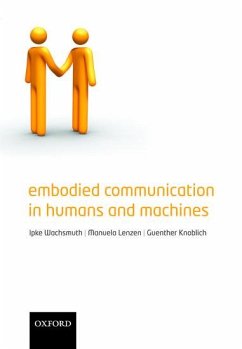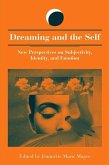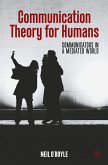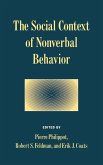Embodied Communication in Humans and Machines
Herausgeber: Wachsmuth, Ipke
Embodied Communication in Humans and Machines
Herausgeber: Wachsmuth, Ipke
- Gebundenes Buch
- Merkliste
- Auf die Merkliste
- Bewerten Bewerten
- Teilen
- Produkt teilen
- Produkterinnerung
- Produkterinnerung
Communication is not just about the transfer of verbal information. Gestures, facial expressions, intonation and body language are all major sources of information during conversation. This book presents a new perspective on communication, one that will help us to better understand humans, and also to build machines that can communicate.
Andere Kunden interessierten sich auch für
![Embodied Environmental Risk in Technical Communication Embodied Environmental Risk in Technical Communication]() Embodied Environmental Risk in Technical Communication205,99 €
Embodied Environmental Risk in Technical Communication205,99 €![Dreaming and the Self: New Perspectives on Subjectivity, Identity, and Emotion Dreaming and the Self: New Perspectives on Subjectivity, Identity, and Emotion]() Dreaming and the Self: New Perspectives on Subjectivity, Identity, and Emotion109,99 €
Dreaming and the Self: New Perspectives on Subjectivity, Identity, and Emotion109,99 €![Communication Theory for Humans Communication Theory for Humans]() Neil O'BoyleCommunication Theory for Humans37,99 €
Neil O'BoyleCommunication Theory for Humans37,99 €![Embodied Activisms Embodied Activisms]() Embodied Activisms134,99 €
Embodied Activisms134,99 €![The Social Context of Nonverbal Behavior The Social Context of Nonverbal Behavior]() Pierre Philippot / S. Feldman / J. Coats (eds.)The Social Context of Nonverbal Behavior149,99 €
Pierre Philippot / S. Feldman / J. Coats (eds.)The Social Context of Nonverbal Behavior149,99 €![Affect and Embodied Meaning in Animation Affect and Embodied Meaning in Animation]() Sylvie BissonnetteAffect and Embodied Meaning in Animation205,99 €
Sylvie BissonnetteAffect and Embodied Meaning in Animation205,99 €![Melancholy Emotion in Contemporary Cinema Melancholy Emotion in Contemporary Cinema]() Francesco SticchiMelancholy Emotion in Contemporary Cinema202,99 €
Francesco SticchiMelancholy Emotion in Contemporary Cinema202,99 €-
-
-
Communication is not just about the transfer of verbal information. Gestures, facial expressions, intonation and body language are all major sources of information during conversation. This book presents a new perspective on communication, one that will help us to better understand humans, and also to build machines that can communicate.
Hinweis: Dieser Artikel kann nur an eine deutsche Lieferadresse ausgeliefert werden.
Hinweis: Dieser Artikel kann nur an eine deutsche Lieferadresse ausgeliefert werden.
Produktdetails
- Produktdetails
- Verlag: Oxford University Press (UK)
- Seitenzahl: 496
- Erscheinungstermin: 15. November 2008
- Englisch
- Abmessung: 251mm x 178mm x 35mm
- Gewicht: 1019g
- ISBN-13: 9780199231751
- ISBN-10: 0199231753
- Artikelnr.: 23581430
- Herstellerkennzeichnung
- Libri GmbH
- Europaallee 1
- 36244 Bad Hersfeld
- gpsr@libri.de
- Verlag: Oxford University Press (UK)
- Seitenzahl: 496
- Erscheinungstermin: 15. November 2008
- Englisch
- Abmessung: 251mm x 178mm x 35mm
- Gewicht: 1019g
- ISBN-13: 9780199231751
- ISBN-10: 0199231753
- Artikelnr.: 23581430
- Herstellerkennzeichnung
- Libri GmbH
- Europaallee 1
- 36244 Bad Hersfeld
- gpsr@libri.de
Ipke Wachsmuth is director of the Center for Interdisciplinary Research (ZiF) and Chair of Artificial Intelligence at the University of Bielefeld. He holds a Mathematics Master's degree and a Ph.D. both from the University of Hannover and an Informatics Habilitation degree from the University of Osnabrück. Before coming to Bielefeld, in 1989, he held faculty and project leader positions in the Department of Mathematics/Computer Science and the Linguistics Department at the University of Osnabrück. He was also assistant professor in the Department of Mathematical Sciences at Northern Illinois University in 1981-83 and research fellow at IBM Germany in 1986-88. Ipke Wachsmuth is a former president of the German Cognitive Science Society and has a strong multidisciplinary commitment, reflected in many research papers published in areas related to the understanding and modeling of human behavior as well as the exploitation thereof in intelligent systems. Manuela Lenzen did her Ph D in Philosophy 2002 at the University of Bielefeld and works as a science writer, free lance journalist and translator. Since 2005 she has been Managing Assistant to the Research Group Embodied Communication in Humans and Machines, ZiF, Bielefeld, Germany Günther Knoblich is currently Professor of Social Cognitive Neuroscience at the University of Birmingham. He received his PhD from the University of Hamburg in 1997. From 1997 to 2004 he was a research scientist in the Cognition and Action group of the Max Planck Institute for Psychological Research. From 2004 to 2007 he was Associate Professor of Psychology at Rutgers University. In 2005 he received the American Psychological Association's (APA) Award for Distinguished Early Career Contribution to Psychology. He is Associate Editor of the journal Social Neuroscience. His research interests include body perception and action perception, the sense of agency, and joint action.
* 1: Ipke Wachsmuth, Manuela Lenzen and Günther Knoblich: Introduction
to embodied communication
* 2: John Barresi: Some boundary conditions on embodied agents sharing
a common world
* 3: J Scott Jordan: Toward a theory of embodied communication:
Self-sustaining wild systems as embodied meaning
* 4: Daniel Richardson, Rick Dale and Kevin Schockley: Synchrony and
swing in conversation: coordination, temporal dynamics and
communication
* 5: Maggie Shiffrar: The visual perception of dynamic body language
* 6: Wolfgang Prinz: Mirrors for embodied communication
* 7: Natalie Sebanz and Günther Knoblich: The role of the mirror system
in embodied communication
* 8: Elisabeth Oberzaucher and Karl Grammer: Everything is movement: on
the nature of embodied communication
* 9: Achim Stephan, Manuela Lenzen, Josep Call and Matthias Uhl:
Communication and cooperation in living beings and artificial agents
* 10: Jürgen Streeck: Laborious intersubjectivity: attentional struggle
and embodied communication in an auto-shop
* 11: Bruno Galantucci and Luc Steels: The emergence of embodied
communication in artificial agents and humans
* 12: Jens Allwood: Dimensions of embodied communication - towards a
typology of embodied communication
* 13: Elisabeth Ahlsén: Neurological disorders of embodied
communication
* 14: Susan Duncan: Gestural imagery and cohesion in normal and
impaired discourse
* 15: Joelle Proust: Conversational metacognition
* 16: Stefan Kopp, Ipke Wachsmuth, James Bonaiuto and Michael Arbib:
Imitation in embodied communication - from monkey mirror neurons to
artificial humans
* 17: Isabella Poggi and Catherine Pelachaud: Persuasion and the
expressivity of gestures in humans and machines
* 18: Timo Sowa, Stefan Kopp, Susan Duncan, David McNeill and Ipke
Wachsmuth: Implementing a non-modular theory of language production
in an embodied conversational agent
* 19: James Bonaiuto and Kristinn R Thórisson: Towards a neurocognitive
model of turntaking in multimodal dialogue
to embodied communication
* 2: John Barresi: Some boundary conditions on embodied agents sharing
a common world
* 3: J Scott Jordan: Toward a theory of embodied communication:
Self-sustaining wild systems as embodied meaning
* 4: Daniel Richardson, Rick Dale and Kevin Schockley: Synchrony and
swing in conversation: coordination, temporal dynamics and
communication
* 5: Maggie Shiffrar: The visual perception of dynamic body language
* 6: Wolfgang Prinz: Mirrors for embodied communication
* 7: Natalie Sebanz and Günther Knoblich: The role of the mirror system
in embodied communication
* 8: Elisabeth Oberzaucher and Karl Grammer: Everything is movement: on
the nature of embodied communication
* 9: Achim Stephan, Manuela Lenzen, Josep Call and Matthias Uhl:
Communication and cooperation in living beings and artificial agents
* 10: Jürgen Streeck: Laborious intersubjectivity: attentional struggle
and embodied communication in an auto-shop
* 11: Bruno Galantucci and Luc Steels: The emergence of embodied
communication in artificial agents and humans
* 12: Jens Allwood: Dimensions of embodied communication - towards a
typology of embodied communication
* 13: Elisabeth Ahlsén: Neurological disorders of embodied
communication
* 14: Susan Duncan: Gestural imagery and cohesion in normal and
impaired discourse
* 15: Joelle Proust: Conversational metacognition
* 16: Stefan Kopp, Ipke Wachsmuth, James Bonaiuto and Michael Arbib:
Imitation in embodied communication - from monkey mirror neurons to
artificial humans
* 17: Isabella Poggi and Catherine Pelachaud: Persuasion and the
expressivity of gestures in humans and machines
* 18: Timo Sowa, Stefan Kopp, Susan Duncan, David McNeill and Ipke
Wachsmuth: Implementing a non-modular theory of language production
in an embodied conversational agent
* 19: James Bonaiuto and Kristinn R Thórisson: Towards a neurocognitive
model of turntaking in multimodal dialogue
* 1: Ipke Wachsmuth, Manuela Lenzen and Günther Knoblich: Introduction
to embodied communication
* 2: John Barresi: Some boundary conditions on embodied agents sharing
a common world
* 3: J Scott Jordan: Toward a theory of embodied communication:
Self-sustaining wild systems as embodied meaning
* 4: Daniel Richardson, Rick Dale and Kevin Schockley: Synchrony and
swing in conversation: coordination, temporal dynamics and
communication
* 5: Maggie Shiffrar: The visual perception of dynamic body language
* 6: Wolfgang Prinz: Mirrors for embodied communication
* 7: Natalie Sebanz and Günther Knoblich: The role of the mirror system
in embodied communication
* 8: Elisabeth Oberzaucher and Karl Grammer: Everything is movement: on
the nature of embodied communication
* 9: Achim Stephan, Manuela Lenzen, Josep Call and Matthias Uhl:
Communication and cooperation in living beings and artificial agents
* 10: Jürgen Streeck: Laborious intersubjectivity: attentional struggle
and embodied communication in an auto-shop
* 11: Bruno Galantucci and Luc Steels: The emergence of embodied
communication in artificial agents and humans
* 12: Jens Allwood: Dimensions of embodied communication - towards a
typology of embodied communication
* 13: Elisabeth Ahlsén: Neurological disorders of embodied
communication
* 14: Susan Duncan: Gestural imagery and cohesion in normal and
impaired discourse
* 15: Joelle Proust: Conversational metacognition
* 16: Stefan Kopp, Ipke Wachsmuth, James Bonaiuto and Michael Arbib:
Imitation in embodied communication - from monkey mirror neurons to
artificial humans
* 17: Isabella Poggi and Catherine Pelachaud: Persuasion and the
expressivity of gestures in humans and machines
* 18: Timo Sowa, Stefan Kopp, Susan Duncan, David McNeill and Ipke
Wachsmuth: Implementing a non-modular theory of language production
in an embodied conversational agent
* 19: James Bonaiuto and Kristinn R Thórisson: Towards a neurocognitive
model of turntaking in multimodal dialogue
to embodied communication
* 2: John Barresi: Some boundary conditions on embodied agents sharing
a common world
* 3: J Scott Jordan: Toward a theory of embodied communication:
Self-sustaining wild systems as embodied meaning
* 4: Daniel Richardson, Rick Dale and Kevin Schockley: Synchrony and
swing in conversation: coordination, temporal dynamics and
communication
* 5: Maggie Shiffrar: The visual perception of dynamic body language
* 6: Wolfgang Prinz: Mirrors for embodied communication
* 7: Natalie Sebanz and Günther Knoblich: The role of the mirror system
in embodied communication
* 8: Elisabeth Oberzaucher and Karl Grammer: Everything is movement: on
the nature of embodied communication
* 9: Achim Stephan, Manuela Lenzen, Josep Call and Matthias Uhl:
Communication and cooperation in living beings and artificial agents
* 10: Jürgen Streeck: Laborious intersubjectivity: attentional struggle
and embodied communication in an auto-shop
* 11: Bruno Galantucci and Luc Steels: The emergence of embodied
communication in artificial agents and humans
* 12: Jens Allwood: Dimensions of embodied communication - towards a
typology of embodied communication
* 13: Elisabeth Ahlsén: Neurological disorders of embodied
communication
* 14: Susan Duncan: Gestural imagery and cohesion in normal and
impaired discourse
* 15: Joelle Proust: Conversational metacognition
* 16: Stefan Kopp, Ipke Wachsmuth, James Bonaiuto and Michael Arbib:
Imitation in embodied communication - from monkey mirror neurons to
artificial humans
* 17: Isabella Poggi and Catherine Pelachaud: Persuasion and the
expressivity of gestures in humans and machines
* 18: Timo Sowa, Stefan Kopp, Susan Duncan, David McNeill and Ipke
Wachsmuth: Implementing a non-modular theory of language production
in an embodied conversational agent
* 19: James Bonaiuto and Kristinn R Thórisson: Towards a neurocognitive
model of turntaking in multimodal dialogue








